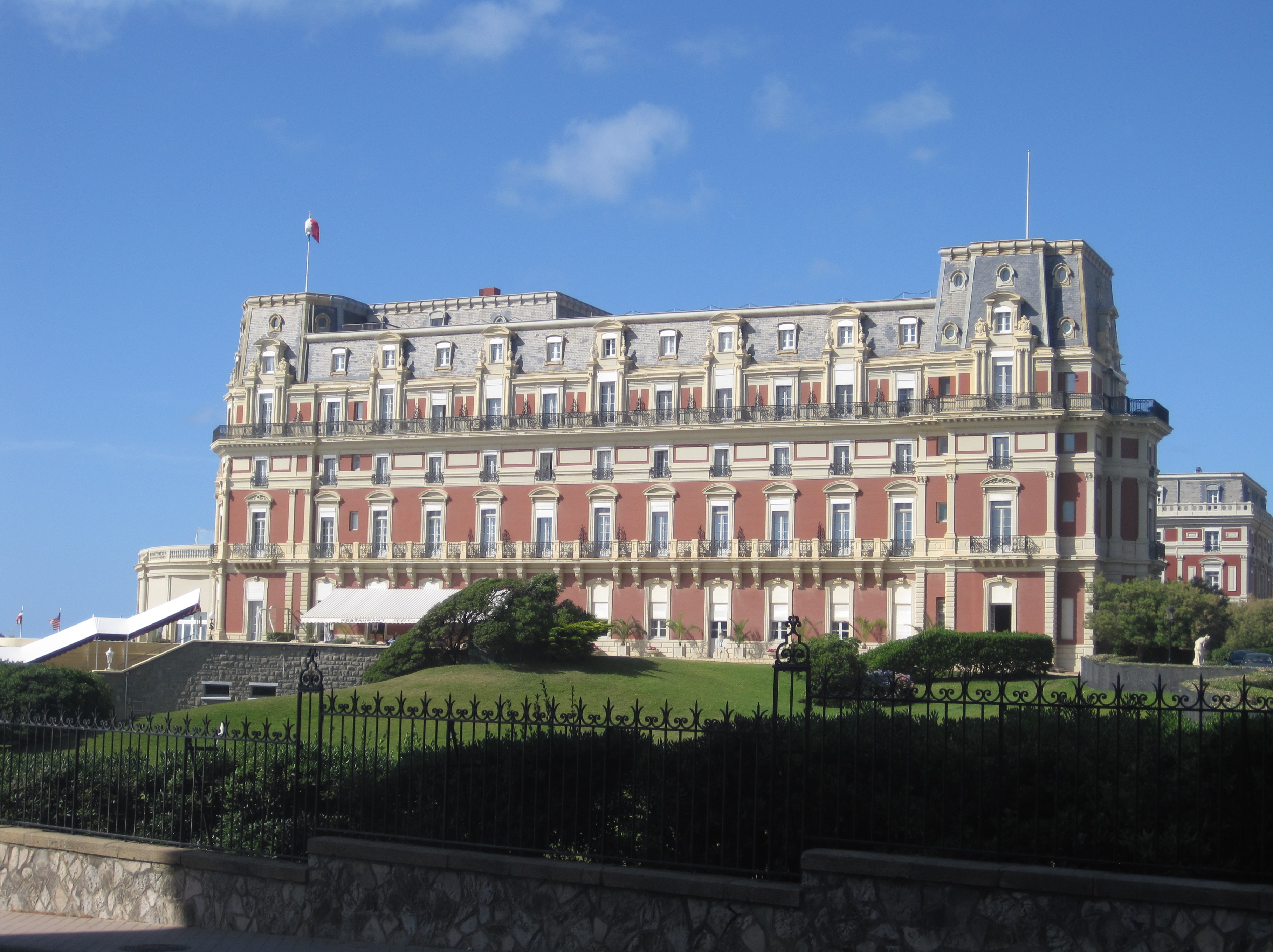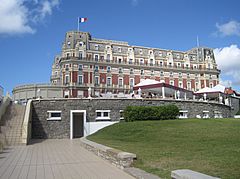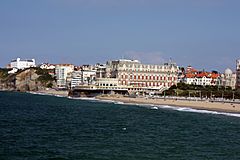Hôtel du Palais facts for kids
| Hôtel du Palais Biarritz | |
Quick facts for kids  View from the south |
|
| Hotel facts and statistics | |
|---|---|
| Location | Biarritz |
| Coordinates | 43°29′12″N 1°33′23″W / 43.486698°N 1.55639°W |
| Opening date | 1855 Reopened 1905 after reconstruction |
| Management | Hyatt |
The Hôtel du Palais Biarritz is a famous luxury hotel located right by the Atlantic Ocean in the town of Biarritz, France. It was first built around 1855 as a summer home for Empress Eugénie, the wife of French Emperor Napoleon III. Because the imperial couple visited often, Biarritz grew from a small village into a popular vacation spot.
In 1880, the villa was sold and turned into a hotel and casino. Sadly, a big fire destroyed much of it in 1903. But it was rebuilt even grander and larger, keeping its original outer walls. For many years, the hotel attracted very important people from all over the world, including European kings and queens like King Edward VII of England. Even though the hotel later faced tough times and closed for a while in the 1950s, it has been beautifully restored. Today, it is once again a top luxury hotel, managed by Hyatt.
Contents
A Royal Summer Home
The hotel stands on the main beach of Biarritz, a town on the rugged coast of the Bay of Biscay, near the Pyrenees mountains. In 1854, Emperor Napoleon III and his wife, Empress Eugénie, bought land in Biarritz. They wanted to build a summer home surrounded by gardens and woods. Napoleon III chose this spot close to Spain so his wife, who was from Spain, wouldn't feel homesick.
Several architects worked on designing the Villa Eugénie. Construction started in 1854. The villa was built in a style called "néo-Louis XIII," which means it looked like buildings from the 1600s. It had a long main building with three wings. At first, some people thought the villa looked too plain for such an important home. Later, it was decorated with busts (sculptures of heads and shoulders) of the imperial family and local figures.
In 1830, the writer Victor Hugo hoped Biarritz would stay natural and unspoiled. However, once the imperial family made it their summer residence, Biarritz quickly became a favorite place for wealthy and noble people to visit. The imperial family spent most of August and September at the villa each year. Early visitors sometimes had mixed feelings about the town. An English magazine in 1858 described it:
... a spot now rendered classic by the visits of our imperial French ally, who has there erected a marine villa—the "Villa Eugénie"—commanding an extensive view of the cruel grey expanse of the Bay of Biscay; the really beautiful landscape towards the Spanish frontier being skillfully excluded. Sans this landscape, and taking the village in itself, lo! we are transported once more to the outskirts of Brighton. Brightonian dwellings, square, and new, and ugly, meet our bewildered gaze on every side, and in miniature proportions. But here the likeness stops. In vain we look for esplanade and goat-chaises; Biarritz boast them not. In vain we sigh for cupola and dome, and, sighing, learn that even the Villa Eugénie lacks the eccentric beauty of our own Pavilion!
Biarritz Becomes a Popular Resort
In 1864, a chapel was built near the villa. It was dedicated to Our Lady of Guadeloupe and blended different art styles, including Roman, Byzantine, and Hispano-Moorish designs. In 1867, the villa itself was renovated, and another floor was added.
Even after the imperial family lost power in 1870, Biarritz remained a fashionable place to visit. In 1880, Empress Eugénie sold the estate. The villa was then turned into a hotel and casino called the "Palais Biarritz." By 1893, it had become a very fancy hotel, hosting royalty like Queen Victoria of England and Empress Elisabeth of Austria, also known as Sisi.
An 1883 travel book noted:
Biarritz is a small but picturesque town, which was brought much into notice by the Empress Eugenie, who used to reside there every year. It is distinguished for its very selected society, which assembles both for sea bathing and the winter season. The scenery is beautiful, although the vegetation in the immediate environs of the town is rather scanty. The town is built like an amphitheatre on the rising cliffs of the Pyrenees, and has some fine modern buildings, of which the Villa Eugenie is one of the most striking.
The Grand Hotel's Rebirth
In 1903, a major fire severely damaged the hotel. Only the imperial chapel was saved. A famous architect named Édouard Niermans was hired to rebuild it. He kept the original outer walls but built a new, stronger structure inside using reinforced concrete. Niermans made the hotel larger, adding two more stories and a grand, curved restaurant with amazing sea views. The new hotel had three hundred rooms and apartments. It also featured bigger rooms for entertaining royalty and a large ballroom in the fancy Second Empire style. The rebuilding was finished in 1905.
The hotel became a top spot for the world's elite. King Edward VII of the UK stayed there many times in the early 1900s. He loved his rooms and found the sea air helped his breathing. In April 1908, a British politician named H. H. Asquith even came to the hotel for the king to officially make him Prime Minister of the UK.
The hotel remained popular even after World War I. In the 1920s, Biarritz was known as the "queen of resorts and resort of Kings." It also attracted movie stars, and politicians. After Spain became a republic in 1931, many Spanish nobles moved to the hotel, close to the border, hoping to return home soon.
Modern Times at the Palais
After World War II, the Hôtel du Palais had to close for a period in the 1950s. The mayor of Biarritz led a campaign to get money to fix up and reopen the building. Their slogan was "No Palace, No Millionaires," showing how important the hotel was to the town's economy.
Famous guests since then have included fashion designer Coco Chanel, actress Ava Gardner, and singer Frank Sinatra. The hotel's outer walls and roofs were recognized as historical monuments in 1993, meaning they are protected. Today, the hotel is a central part of modern Biarritz, easily reached through beautiful iron gates from the main shopping street.
As of 2012, the hotel had 124 rooms and 30 suites, all decorated in a classic style. It features excellent restaurants, a bar, and a pool. The decor still reminds visitors of the hotel's royal past, and prices are quite high. The hotel is surrounded by historic grounds, reached by a grand driveway. In 2018, the hotel joined the Unbound Collection, a group of unique hotels managed by Hyatt.
Gallery
See also







